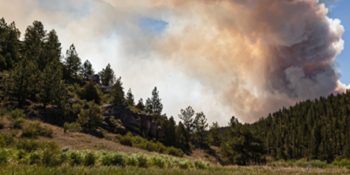
Numerous wildfires popping up in the Western United States over the past few weeks emphasize the importance of air quality monitoring and smoke forecasting for public health. In Colorado, a team of scientists at the Department of Public Health and Environment’s Air Pollution Control Division monitor air quality seven days a week.
Air quality monitoring is the measurement of various types of pollutants found in the air. One key air pollutant in wildfire smoke is PM2.5, composed of microscopic particles created in the burning process that become suspended in the air. The monitoring team uses a network of monitors around the state to keep track of air quality and pollutants, including PM2.5. During wildfires, the team also sometimes works with the U.S. Forest Service to deploy mobile monitors in areas where they expect the greatest smoke impacts.
Even if no monitors are available, the team uses satellite imagery and web cameras to estimate the potential impact of smoke on affected communities. Based on weather forecasting and wind patterns, the team can predict where wildfire smoke will migrate and use these predictions to issue Air Quality Advisories in areas where smoke levels may become unhealthy.
“Currently, most of the fires in Colorado are not producing much in the way of smoke,” explained Scott Landes, supervisor of the Meteorology and Prescribed Fire Unit in the division. “We are entering a period where we are expecting more rain across the state as well, which is certainly a good thing in keeping the smoke down.” Despite this, Landes warns that the threat of thunderstorms can also increase the threat of new fires being started due to lightning strikes, so the team will be monitoring this over the next several days.
If there is heavy smoke in your area, you may want to remain indoors with the windows and doors shut. The effects of smoke can be especially hard on people with heart disease or lung illnesses, or people who are very young or elderly.
If you live in an area with high levels of smoke in the air, you can determine if the levels are unhealthy by focusing on a landmark 5 miles away. “If you can no longer see that landmark, the air is unhealthy to breathe,” Landes said.
If you are concerned about wildfire smoke in your area, visit our smoke outlook website for daily updates about wildfire smoke around the state. To obtain general information on current air quality in Colorado, go to our air quality summary website or call the 24-hour Air Quality Advisory Hotline at 303-758-4848 or toll free at 1-888-484-3247 (1-888-4-THE-AIR).

Leave a Reply